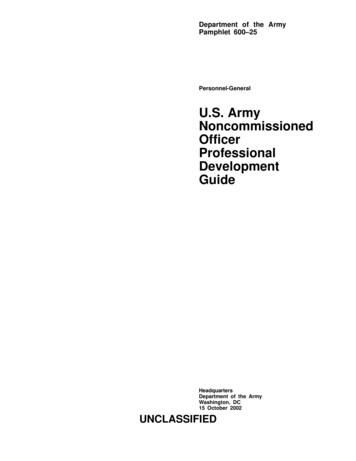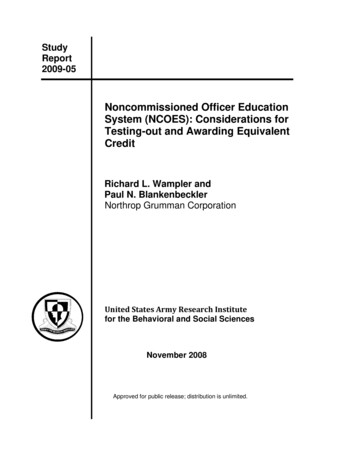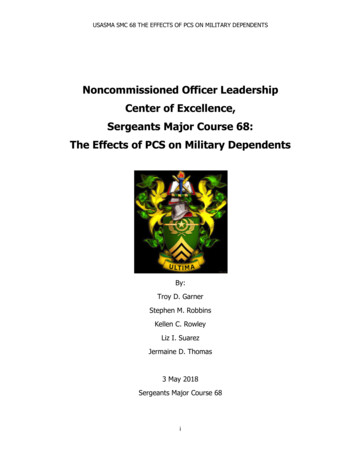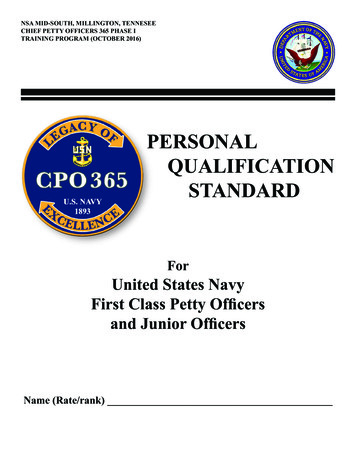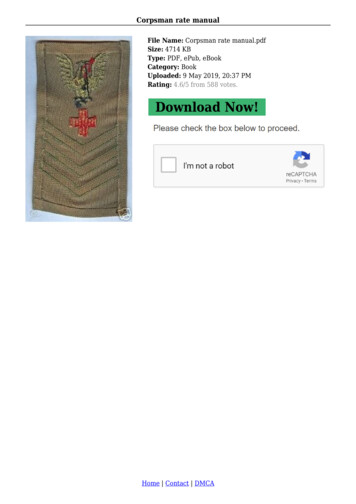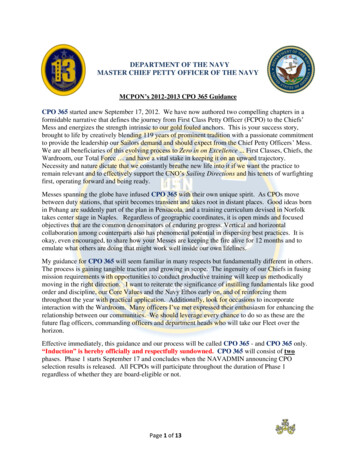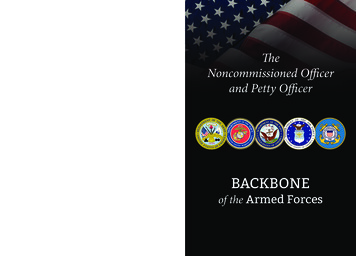
Transcription
—Chuck HagelSecretary of DefenseThe Noncommissioned Officer and Petty Officer BACKBONE of the Armed Forces“Noncommissioned officers and petty officers are truly theBackbone of America’s military strength, and the Departmentof Defense depends on their leadership, integrity, anddedication to accomplish our mission. As a former Armysergeant, I know how much trust and responsibility areplaced in the hands of our NCOs and POs. By explainingwhat it means to be a leader in the strongest military in theworld, this book will help ensure that today’s and tomorrow’snoncommissioned officers and petty officers understand theproud legacy they have inherited.”TheNoncommissioned Officerand Petty OfficerBACKBONEof the Armed Forces
This book is presented to:From:Date:
TheNoncommissioned Officerand Petty Officer
TheNoncommissioned Officerand Petty OfficerBACKBONEof the Armed ForcesNational Defense University PressWashington, D.C.2014
Published in the United States by National Defense University Press. Portions of this bookmay be quoted or reprinted without permission, provided that a standard source credit line isincluded. NDU Press would appreciate a courtesy copy of reprints or reviews.Opinions, conclusions, and recommendations expressed or implied within are solely those ofthe contributors and do not necessarily represent the views of the Defense Department or anyother agency of the Federal Government. Cleared for public release; distribution unlimited.Library of Congress Cataloging-in-Publication DataThe noncommissioned officer and petty officer : backbone of the armed forces.pages cm“Through the direction of the Office of the Senior Enlisted Advisor to the Chairman of theJoint Chiefs of Staff, this book was written by a team of enlisted leaders representing the U.S.Army, Marine Corps, Navy, Air Force, and Coast Guard with the participation and support ofthe National Defense University.”1. United States—Armed Forces—Non-commissioned officers—History. 2. United States.Navy—Petty officers—History. 3. United States. Coast Guard—Petty officers—History. I.United States. Office of the Senior Enlisted Advisor to the Chairman of the Joint Chiefs of Staff.II. National Defense University Press.UB408.N66 2013355.3’38—dc232013048346Book design by Chris Dunham, U.S. Government Printing OfficeCover concept by Hugo Cantu, U.S. Army Sergeants Major AcademyNational Defense University Press260 Fifth Avenue (Building 64)Suite 2500Fort Lesley J. McNairWashington, DC 20319NDU Press publications are sold by the U.S. Government Printing Office. For orderinginformation, call (202) 512–1800 or write to the Superintendent of Documents, U.S.Government Printing Office, Washington, D.C. 20402. For GPO publications online, accessits Web site at: http://bookstore.gpo.gov.
ContentsFOREW ORDby General Martin E. Dempsey, USA, 18th Chairman ofthe Joint Chiefs of Staff. . . . . . . . . . . . . . . . . . . . . . . . . . . . . . . . . . . . . . . . . . . . . . . . . . . . ixPREFACEby Sergeant Major Bryan B. Battaglia, USMC, Senior EnlistedAdvisor to the Chairman of the Joint Chiefs of Staff. . . . . . . . . . . . . . . . . . . . xiACKNOW LED G M E N TS . . . . . . . . . . . . . . . . . . . . . . . . . . . . . . . . . . . . . . . . . . . . . . . . . .xivINTRODUCTI O NThe Backbone of the Armed Forces. . . . . . . . . . . . . . . . . . . . . . . . . . . . . . . . . . . . . 1CHAPTER ON ENoncommissioned Officers/Petty Officers:Who They Are, What They Do. . . . . . . . . . . . . . . . . . . . . . . . . . . . . . . . . . . . . . . . . . 7CHAPTER TW OThe Profession of Arms: An Ancient and Honorable Tradition. . . . . . 19CHAPTER TH RE ESteward of the Institution. . . . . . . . . . . . . . . . . . . . . . . . . . . . . . . . . . . . . . . . . . . . . . . 27CHAPTER F O URComplementing the Officer. . . . . . . . . . . . . . . . . . . . . . . . . . . . . . . . . . . . . . . . . . . . . 39vii
C HAPTER F IVEEnabling the Force. . . . . . . . . . . . . . . . . . . . . . . . . . . . . . . . . . . . . . . . . . . . . . . . . . . . . . . 47C HAPTER S IXService Identity and Joint Warfighting. . . . . . . . . . . . . . . . . . . . . . . . . . . . . . . . . 55C HAPTER S EVENInternational Roles. . . . . . . . . . . . . . . . . . . . . . . . . . . . . . . . . . . . . . . . . . . . . . . . . . . . . . 81A F TERW ORDThe Service Continues. . . . . . . . . . . . . . . . . . . . . . . . . . . . . . . . . . . . . . . . . . . . . . . . . . . 89A PPENDIX AFounding Documents. . . . . . . . . . . . . . . . . . . . . . . . . . . . . . . . . . . . . . . . . . . . . . . . . . . 93The Declaration of Independence. . . . . . . . . . . . . . . . . . . . . . . . . . . . . . . . . . 95The Constitution of the United States. . . . . . . . . . . . . . . . . . . . . . . . . . . . 101A PPENDIX BAuthorizing Statutes for the Armed Forces. . . . . . . . . . . . . . . . . . . . . . . . . . . 131A PPENDIX CService Values of the Armed Forces. . . . . . . . . . . . . . . . . . . . . . . . . . . . . . . . . . . 137A PPENDIX DCode of Conduct for Members ofthe United States Armed Forces. . . . . . . . . . . . . . . . . . . . . . . . . . . . . . . . . . . . . . . 138viii
ForewordAll of us who have served in uniform—from the newest recruits tofour-star generals and admirals—have respected and learned fromthe outstanding men and women who wear the chevrons, anchors,and stripes of our noncommissioned officer and petty officer corps.We know them to have exceptional competence, professional character, and soldierly grit—they are exemplars of our Profession ofArms.Through the nature of their charge, our force’s mid-level enlistedcorps bears tremendous responsibility for accomplishing the mission. Just as important, they uphold the moral obligation for the careand success of the men and women they lead.The mid-grade enlisted force plays a unique role within the entire force. They are the frontline of our profession. They representour values, behaviors, and character to our most junior ranks everyday, no matter what transitions we face today or challenges we willface. Noncommissioned officers and petty officers also safeguard thevoice of the enlisted force, informing senior leaders’ decisions withcandor and care.Our noncommissioned officers and petty officers have chosenthe uncommon life unique to all members of the Profession of Arms,a life of service and sacrifice, grounded in our sacred oath to defendthe Constitution. I am enormously proud of them. Their honorableservice on and off the battlefield has earned America’s respect andtrust. And the mutual trust they build with their subordinates, peers,and superiors enables them to be the Backbone of the Armed Forces.ix
To the intrepid noncommissioned officers and petty officers whowill use this book to advance your careers and our profession, thankyou for your service and for the example you provide to the force.—Martin E. DempseyGeneral, U.S. Army18th Chairman of the Joint Chiefs of Staffx
PrefaceShortly after I was sworn into office by the 18th Chairman of the JointChiefs in October 2011, the Chairman and I met for a discussion aboutthe Profession of Arms—a topic important to any of us who honorablywear the cloth of the Nation. For quite some time before that, I hadlonged for a way to capture what our nation’s noncommissioned officercorps is all about: why they are so trusted and empowered, the professional commitment to help achieve our nation’s objectives, and themoral obligation to care for America’s sons and daughters who servein uniform. By the end of the conversation, we agreed that writing abook about the Armed Forces noncommissioned officer and petty officer was not only the right idea but also, perhaps even more compelling,long overdue. The basic concept was to produce a book of, by, and fornoncommissioned officers and petty officers.On December 17, 1777, General George Washington’s army returned to winter quarters in Valley Forge, Pennsylvania, tired and withlittle strategic success in their fight against the professional Britisharmy. This period in Valley Forge proved critical for the fledgling army.General Washington recruited a former Prussian officer, Baron Friedrich Wilhelm Von Steuben, as Inspector General to strengthen theprofessionalism of the colonial army. Von Steuben’s training objectivesconstituted the first written plan for standards, discipline, and duty forWashington’s army, and he initiated the first training manual that outlined the duties and responsibilities of the noncommissioned officer.So in an important way, December 17 is considered the birthdate ofAmerica’s noncommissioned officer corps.To accomplish this rather huge endeavor, I assembled a select groupof enlisted leaders, representing the five military Service branches,xi
National Guard, and special operations forces as the primary writingteam. Managed by two co-leaders, this writing team was entrustedwith a charge: to write a book that holistically defines the nature andcalling of the U.S. Armed Forces noncommissioned officer and petty officer. Grounded in the Profession of Arms and distinctive in itsown right, this book complements the Department of Defense’s TheArmed Forces Officer, as well as the Services’ noncommissioned officer and petty officer doctrinal manuals. The writing team was chargedto make certain that their work accurately captures the attributes andcompetencies of noncommissioned officers and petty officers across allService branches through the lenses of both war and peace. It is not a“how to” or instructional manual. Rather, it is focused on defining andcharacterizing the noncommissioned officer and petty officer.Teamwork is a bedrock operating principle from the first day of ourmilitary life cycle. The team of writers (listed in the acknowledgments)worked seamlessly to produce an inspiring book about who we are,what we do, and why we do it. They remained mindful of the differingService cultures and identities, and they sought to avoid an inadvertentdilution of any particular Service’s expectations or standards. Becausethe Navy and Coast Guard use the term petty officer rather than noncommissioned officer, the authors made a conscious decision to conjointhe terms and use the initialism NCO/PO in order to reflect the proudheritage of these enlisted leaders and their Service cultures.This book seeks to inspire, validate, and ultimately resonate withevery Soldier, Marine, Sailor, Airman, and Coastguardsman—past,present, and future. It aims to pay appropriate tribute to the contributions of NCOs/POs in each branch of the Armed Forces.All of us who were involved in producing this book hope that itfinds a spot on your nightstand, qualifies for a place on a commander’s reading list, and becomes a standard text for the various enlistedleadership academies. We want the book to serve as a working tool torenew our commitment to our profession. We would like it to be readnot only by serving and former NCOs/POs but also by all junior enlisted aspiring to become enlisted leaders. We would like it to be digestedby our officer corps so that they may fully recognize what our enlistedleaders bring to the units and organizations in which they serve. Wehope our military veterans will treasure this book as they look backxii
with pride on their own service to the Nation. Finally, we hope that ourcomrades in arms in other nations, who are an important part of ourhistory, will likewise benefit from reading this book.As I reflect on all that our Servicemembers do in the defense of theNation, I am extremely humbled by their dedication to duty and theirsacrifice. These patriots, whom I have served alongside—and served—during my career, obligate themselves to lead, motivate, develop, andachieve.As you read this book, I believe you will see that it encapsulateswhy our noncommissioned officers and petty officers still proudly carry the torch as the Backbone of our Armed Forces.—Bryan B. BattagliaSergeant Major, U.S. MarinesSenior Enlisted Advisor to the Chairmanof the Joint Chiefs of Staffxiii
AcknowledgmentsThrough the direction of the Office of the Senior Enlisted Advisor tothe Chairman of the Joint Chiefs of Staff, this book was written by ateam of enlisted leaders representing the U.S. Army, Marine Corps,Navy, Air Force, and Coast Guard with the participation and supportof the National Defense University. This enduring project—to defineand holistically characterize the role of the noncommissioned officer/petty officer in the Armed Forces—proved a daunting one but longoverdue.All members of the writing team, except one, were serving orretired NCOs/POs. They represented the Active and Reserve components, including the Army and Air National Guards. The militaryauthors’ specialties and backgrounds covered a wide array of conventional and special operations, each with extensive experience in Service, joint, and coalition formations during national crisis, war, andpeace. Co-leaders and members of the writing team (with their organization affiliations when they worked on this project) are:Co-leaders:Chief Master Sergeant Curtis L. Brownhill, USAF (Ret.), formerU.S. Central Command Senior Enlisted AdvisorDr. Albert C. Pierce, Professor of Ethics and National Security,National Defense UniversityWriting team members:Command Master Chief (SS/EXW) Donald B. Abele, USN,Deputy Director, U.S. Navy Senior Enlisted Academyxiv
Command Chief Master Sergeant Reginald Edwards, USAF,District of Columbia National Guard Senior Enlisted LeaderCommand Sergeant Major Richard Espinoza, USA, District ofColumbia National Guard, Land Component CommandMaster Gunnery Sergeant Andrew Hampton, USMC, SecondMarine Division, G3 OperationsMaster Sergeant James P. Horvath, USMC, Joint Special OperationsForces Senior Enlisted Academy, Special Operations CommandMaster Sergeant Douglas J. Schmidt, USAF, Instructional SystemsDesigner, NCO Academy Curriculum, Thomas N. Barnes Center forEnlisted EducationMaster Sergeant Joel C. Zecca, USA, Director, U.S. Army AdvancedLeader Course—Common Core (DL), United States Army SergeantsMajor AcademyChief Petty Officer C.C. Clayton, USCG, Public Affairs,Headquarters U.S. Coast GuardThe members of the writing team wish to thank and commendseveral individuals and organizations for their outstanding contributions to this project:NDU Press, especially Dr. Jeffrey D. Smotherman for his superbeditingGeneral Richard B. Myers, USAF (Ret.), Command SergeantMajor Jeff Mellinger, USA (Ret.), Command Sergeant Major MarkRipka, USA (Ret.), and Dr. Rick Swain for their executive review ofthe manuscript and offering invaluable suggestions for improving thebookGPO Creative Services, particularly Chris Dunham for his originaldesign work and typesettingHugo Cantu of the U.S. Army Sergeants Major Academy for histalented graphic support and cover concept.xv
David M. SharpSergeant First Class Leroy Petry, USA, awarded Medal of Honor in 2009 for actions inAfghanistan
IntroductionThe Backbone of the Armed ForcesTo be a member of the United States Armed Forces—to wear the uniform of the Nation and the stripes, chevrons, or anchors of the militaryServices—is to continue a legacy of service, honor, and patriotism thattranscends generations. Answering the call to serve is to join the longline of selfless patriots who make up the Profession of Arms. This profession does not belong solely to the United States. It stretches acrossborders and time to encompass a culture of service, expertise, and, inmost cases, patriotism. Today, the Nation’s young men and women voluntarily take an oath to support and defend the Constitution of theUnited States and fall into formation with other proud and determinedindividuals who have answered the call to defend freedom. This splendid legacy, forged in crisis and enriched during times of peace, is deeply rooted in a time-tested warrior ethos. It is inspired by the notionof contributing to something larger, deeper, and more profound thanone’s own self.Strengthened by the diversity of its citizens, the United States remains a global vanguard of freedom, democracy, human rights, andopportunity. The monumental task of keeping the Nation secure, protecting its citizens, and assisting in crisis across the globe often fallson the shoulders of the United States Armed Forces. Comprised of Active-duty, Reserve, and National Guard components, today’s all-volunteer Total Force is led by committed and trusted leaders—officersand noncommissioned officers (NCOs)/petty officers (POs) who embody the discipline, intellect, and fortitude needed to support our national security strategy and help achieve its national objectives. Theirs1
is a solemn obligation fortified by the sacred trust of the Americanpeople. This trust looks not only for well-planned execution of military operations and responsible management of national resources,but also for the care of its most precious treasure—America’s sons anddaughters.At the beginning of this project, the writing team crafted a paragraph to define and characterize NCOs/POs. The book drew its shapeand focus from this original paragraph:As an enlisted member in the Armed Forces of the UnitedStates, you are a member of the Profession of Arms and havetaken an oath of enlistment to support and defend the Constitution. When you become a Noncommissioned Officer or PettyOfficer, you are then an empowered and trusted leader in America’s all-volunteer force. As a leader and technical expert, youenhance organizational effectiveness and directly contributeto mission success. Innovative, adaptive, and resilient, you arethe indispensable link between command guidance and execution, ensuring that each task is fully understood and supervisedthrough completion. You are responsible and accountable for thedevelopment and welfare of your subordinates. You teach, coach,and mentor them. As a steward of the institution, you enforce itsstandards and are its ambassador to the world.The writing team concluded that NCOs/POs are the bridging leaders within every Service branch. The dual roles of NCOs/POs may bebest described as “complement the officer, enable the force.” How bothare done by the NCO/PO is much more art than science. The collectivecapacity of the NCO/PO ranks, junior to senior, forms a distinct andinvaluable leadership cadre that balances artfully between mission andpeople. NCOs/POs possess professional qualities, competencies, andtraits that complement the officer corps and enable the enlisted force.They are trusted and empowered leaders in the Profession of Arms—the Backbone of the Armed Forces.This book aims to define and illustrate who NCOs/POs are, whatthey do, and why they are a critical enabler within the Armed Forces.2
Each chapter builds upon concepts and foundations from other chapters, offering a continuity of core ideas. If the authors have been successful, the audience should conclude not only that NCOs/POs arebona fide members of the Profession of Arms, but also that, given theirextraordinary roles and responsibilities, NCOs/POs are quintessentialleaders within the profession.The clear evolution of NCOs/POs, from traditional supportingfigures to empowered and integrated leaders, spans all five militaryServices. It is a product of thoughtful institutional investment and theremarkable accomplishments over centuries of service. Today’s NCOs/POs benefit tangibly from the legacy of those who served before. As aresult of their predecessors’ deeds and remarkable successes, today’sNCOs/POs serve both in ways their predecessors would still recognizeand in ways almost unimaginable only a few decades ago. With one eyeon the past and one on the future, the Armed Forces have re-evaluatedthe knowledge, skills, and abilities of enlisted leadership and adaptedthem for current and future requirements, yielding today’s professional enlisted force. As an outcome of this evolutionary effort, NCOs/POsare now empowered to assume added roles and responsibilities—withcommensurate accountability—once reserved for the commissionedofficer corps in each Service.American NCOs/POs are distinctive in the global Profession ofArms. This is a result of their common professional education, training, and development. NCOs/POs are expected to do the right thingfor the right reasons, irrespective of influence, complexity, or urgency.This high degree of trust and confidence is institutionalized withinthe Armed Forces by both superior officers and the enlisted men andwomen whom NCOs/POs are responsible for developing and leading.General James N. Mattis, USMC (Ret.), aptly described why theNation needs its Armed Forces: “We’re going to have to fight to defendthis experiment we call ‘America,’ to see if a government of the people,by the people and for the people can survive in an inhospitable environment. If we want the values that grew out of the Enlightenmentto survive, we’re going to have to fight.” This means to fight for theNation and to maintain the honor and reputation of the Profession ofArms. The lineage of the Profession of Arms and the Armed Forcesof the United States has been fortified by millions of uniformed men3
and women. Many have paid the price of anguish, pain, blood, limb,and life. And many others carry invisible scars from the weight of war,conflict, and service around the globe.America’s corps of enlisted leaders and its longstanding reputationhave been forged by patriotic men and women maintaining unwavering standards during extraordinary times, and by those who havecarried the colors forward into past battles, campaigns, and wars onbehalf of the Nation. The “Gold Star” mother, who has endured the immense burden of sacrifice within her family, must find comfort in theknowledge that her country’s Armed Forces will continue to protectthe Nation from tyranny and oppression, and that her son or daughterwas entrusted to and led by the finest leaders, the noncommissionedofficers and petty officers.Ultimately, this book belongs to the U.S. military’s noncommissioned officers and petty officers—past, present, and future. With greatrespect and admiration to those who have ever worn—and to thosewho aspire to wear—stripes, chevrons, or anchors, the dedicated writing team humbly presents this book as an inspiring testament aboutthe Backbone of the Armed Forces.4
James CoxFighting with 2nd Infantry Division north of the Chongchon River, Sergeant First ClassMajor Cleveland, weapons squad leader, points out communist-led North Korean position to his machinegun crew, November 20, 1950
CHA PTE R O N ENoncommissioned Officers/Petty Officers: Who They Are,What They DoAs we finished another evening meal at this forward operatingbase, I was drawn to a familiar commotion. A U.S. Army guntruck team led by a staff sergeant arrived barely in time to catcha late dinner. It was obvious this team had just returned fromanother grueling combat mission on the road. They looked tired,tattered, and hungry. Still wearing full body armor and carryingtheir rifles properly slung and secured, they made their way tothe meal line. The NCO stayed back, allowing his team to gettheir meals and eat first. As the most junior ranking member,a private first class, passed him, the sergeant placed a comforting hand on the young man’s shoulder and asked, “Hanging inthere, Adams?” “Hooah, staff sergeant,” the Soldier replied reassuringly as he grabbed a tray and utensils. The staff sergeantwas the last to join his team at their table. They enjoyed a brieftime of comradeship as he quickly scoffed down his meal, andwithin minutes, began gathering his equipment. Standing backup, he informed the men that he was off to brief battalion, placing his next ranking sergeant in charge, and leaving in a hurry.I often find myself thinking back to that deployment andto that evening. I admired the solidarity and cohesion that existed among that gun truck unit and the comportment of thatNCO. It was apparent to me that he was the mainstay of thatteam. He demonstrated competence, confidence, and a tireless7
sense of duty to his cause, his command, and his comrades inarms. He placed the needs and well-being of his team ahead ofhis own, without sacrificing established standards, discipline, orethical behavior. He served not only as a leader to his men, buta follower to his leadership. He embodied the strength, versatility, selflessness, grit, and dedication of the enlisted military professional, and he personified the reason why noncommissionedofficers and petty officers are, indeed, the Backbone of the U.S.Armed Forces.This personal account from a senior noncommissioned officerwho observed the scene is just one depiction of the noncommissionedofficer/petty officer in action, as seen through the eyes of a fellow Servicemember. Similar stories of NCO/PO dedication are found in thememories of veterans of World War II, the Korean War, the VietnamWar, and other conflicts of the 20th and 21st centuries. Not all of thesestories unfold in a war zone; some occurred in stateside barracks, onships in homeport, and at airbases around the globe. But what do theyhave in common?Regardless of Service, every NCO/PO shares a core essence and ancestry grounded in ready obedience, selfless dedication, and uncompromising integrity. As stewards of the enlisted force, NCOs/POs serve asprotectors, guides, and guardians to America’s sons and daughters whohave committed themselves to defending the Constitution, as well as theNation’s values, freedoms, and way of life. They are responsible for developing, preparing, sustaining, and advancing the enlisted force to meetthe challenges of the 21st-century global security environment. Whetherviewed through the eyes of a fellow enlisted Servicemember, commissioned officer, retired veteran, citizen of a foreign nation, parent, spouse,or child, today’s NCOs/POs are the quintessential leaders to their subordinates, loyal followers to their leaders, and an inspiration to all.The Servant-LeaderThe Armed Forces preserve a legacy of loyalty, honor, commitment,and perseverance that has stood the test of time and the hardships ofconflict and chaos. A deeper look reveals the rich history of the NCO/8
PO in shouldering immense responsibility as trusted leaders and serving proudly at the forefront. The trust, granted by their commandsand witnessed by the American people, relies on their conduct andcharacter to ensure that the members of the Armed Forces perform tothe standards expected of them. As empowered leaders of the enlistedforce, NCOs/POs are in the most advantageous position to influence,motivate, and develop their Soldiers, Marines, Sailors, Airmen, andCoastguardsmen so that they enthusiastically want to work towardand achieve the goals established for the common good. As disciplinedand devoted professionals, they follow orders and faithfully carry outresponsibilities while ensuring that they themselves, and the men andwomen in their charge, comply with all laws and regulations and exercise sound moral reasoning to ensure highly ethical conduct.From the most junior NCO/PO to the most senior enlisted advisorsacross the five Service branches, NCOs/POs are skilled and professional leaders, critical to all levels of military organization and command.While all those who have successfully completed initial military training have proudly earned the title of Soldier, Marine, Sailor, Airman,or Coastguardsman, NCOs/POs are the specially trusted leaders whoprovide an indispensable and irreplaceable linkage between commandguidance and mission execution. They are the competent, credible, andcapable servant-leaders who influence and impact every aspect of anorganization’s operations, administration, and climate. They embodyand enforce high standards and live by an austere code of conduct,maintaining an ethical and moral high ground and unwavering dedication to duty. A true and devoted NCO/PO is the embodiment ofresponsibility and accountability, never shirking his duty.As technical and functional experts, specialized practitioners,and advisors steeped in tactics, techniques, and procedures, NCOs/POs carry out both the art and the science of the Profession of Arms.Subordinates and commanders alike draw upon enlisted leaders’ expertise and experience to achieve mission objectives and depend onthem as leaders and managers. NCOs/POs are expected to acquireand employ applicable resources efficiently and effectively, to thinkcritically to prevent and solve problems. Moreover, they must be ableto communicate continually up, down, and across Service, joint,and coalition chains of command. They accrue extensive practical9
experience and specialized training, professional military education,and mentoring, all of which further enhance their capabilities. It isthrough this dynamic process of development and maturation thatNCOs/POs emerge from the ranks as the most seasoned Servicemembers capable of not only leading the enlisted force of today but alsodeveloping military leaders for tomorrow.Heroic and righteous acts of selfless physical and moral couragehighlight the history and fidelity of the NCO/PO—sometimes incredible deeds performed for the sake of their fellow Servicemembers, theirnation, and its vital interests. But NCOs/POs contribute every day, inways small and large, obvious and subtle, in war and in peace, overseasand at home. Each action, decision, and behavior is a reflection of thatindividual military member’s character and professionalism. NCOs/POs cultivate the virtues of decency, fairness, honesty, humility, integrity, and valor through their own actions—by walking the walk, notsimply talking the talk. They play a vital role in upholding the traditionand image of the Profession of Arms by instilling its noble qualities inothers. It is the skill and character of NCOs/POs that earn the admiration, trust, and respect of their subordinates, peers, supe
Teamwork is a bedrock operating principle from the first day of our military life cycle. The team of writers (listed in the acknowledgments) worked seamlessly to produce an inspiring book about who we are, what we do, and why we do it. They remained mindful of the differing Service cultures and identities, and they sought to avoid an inadvertent



